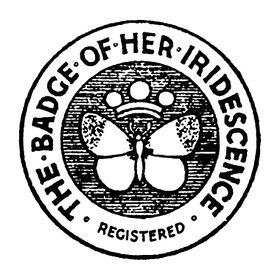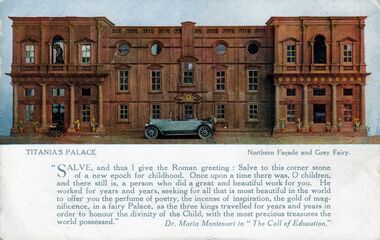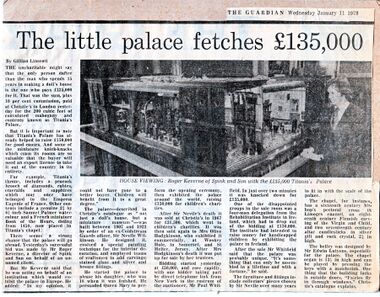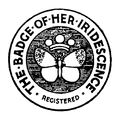Category:Titania's Palace
"The Badge of Her Iridescence", Titania's Palace logo used on the Tuck's Postcards series [image info]
Titania's Palace, Northern Facade (Raphael Tuck postcard [image info]
1978: Titania's Palace auctioned [image info]
Titania's Palace is a famous and extravagantly exquisite dollhouse built in Ireland by the cabinetmakers James Hicks & Sons, under commission from Sir Nevile Wilkinson (1869 – 1940).
The eighteen-room dollhouse is built to standard 1:12 dollhouse scale, and was built over a period spanning approximately 1907 to 1922, and is full of miniature artworks and antique dollhouse furniture. The palace was exhibited in Ireland and around the world, raising money for Irish children's charities.
It's rated as one of the World's greatest dollhouses, along with Queen Mary's Dolls' House, and Titania's replacement, Tara's Palace.
The car
Unusually for Fairy Queens, Queen Titania also apparently owned a 1/12-scale car called the Grey Fairy, a ~1907 15hp Humber Tourer.
1922 description
BUILT FOR TITANIA: AN INCH-TO-THE-FOOT "PALACE"
Sir Neville Wilkinson tells on the opposite page how he came to build Titania's Palace, which might be described as a "super doll's house", practically a museum in miniature of Italian art. The story is told at length in his book, "Yvette in Italy and Titania's Palace", published by Messrs. Hodder and Stoughton. Part of the profits of the book are to be divided between The League of Pity (National Society of the Prevention of Cruelty to Children) and The Children's Union (Waifs and Strays). The above photograph shows the Vestibule, the smallest portion of the building. It is Florentine in feeling, and the shields of arms held by the fairies are those of the Guilds of Florence.; while on the coved ceiling are the arms of the principal Florentine families. Sir Neville has worked the whole scheme on the scale of one inch to one foot. The interior decoration was also carried out by them, with the assistance of friends and fellow-craftsmen who carry out his designs. He only commenced this palace since the war, and has done practically all the interior himself, in his spare time. The exterior is the work of Mr James Hicks and Mr Thomas Lennon, of Dublin. The whole building covers an area of about fifty square feet.
— , -, , The Illustrated London News, , 11th February 1922
1967, 1978 auctions, relocation to Egeskov Castle, Denmark
When further touring became impractical, the palace was put up for auction in 1967, and moved to England where it stayed for around ten years (exhibited at Wookey Hole) before being auctioned again, at which point it was widely assumed that it would end up back in Ireland.
However, the dollhouse was bought at this second auction in 1978 by the Lego company and is currently on display in the Rigborg Room, Egeskov Castle, Denmark.
1978 sale
The little palace fetches £135,000
by Gillian Linscott
THE uncharitable might say that the only person dafter than the man who spends 15 years in making a doll's house is the one who pays £135,000 for it. That was the sum, plus 10 per cent commission, paid at Christie's in London yesterday for the 200 cubic feet of convoluted mahogany and contents known as Titania's Palace.
But it is important to note that Titanla's Palace has already helped to raise £150,000 for good causes. And some of the miniature knick-knacks which cram its rooms are so valuable that the buyer will need an export licence to take it out of the country in its entirety.
For example, Titania's throne, includes a peacock brooch of diamonds, rubies, emeralds and sapphires which may once have belonged to the Empress Eugenie of France. Other contents include a genuine 2¾ by 6¼ inch Samuel Palmer watercolour and a French miniature Book of the Hours, dating from 1450, now placed in Titania's chapel.
There seems a strong chance that the palace will go abroad. Yesterday's successful bid was made by Mr Roger Keverne, a director of Spink and Son on behalf of an unnamed client.
But Mr Keverne said that he was acting on behalf of an institution which would exhibit the palace in Europe. He added: "In my opinion, it could not have gone to a better buyer. Children will benefit from it to a great degree."
The palace – described in Christie's catalogue as "not Just a doll's house, but a miniature museum" – was built between 1907 and 1922 by order of an ex-Coldstream Guards officer, Sir Nevile Wilkinson. He designed it, evolved a special painting technique for the interior decoration, and employed teams of craftsmen to add carvings, stained glass and silver and bronze fittings.
He started the palace to please his daughter, who was 18 when it was finished. He persuaded Queen Mary to perform the opening ceremony, then exhibited the palace around the world, raising £150,000 for children's charities.
After Sir Nevile's death it was sold at Christie's in 1967 for £31,500, which went to children's charities. It was then sold again to Mrs Olive Hodgkinson, who exhibited it commercially, at Wookey Hole, in Somerset, and St Helier, Jersey. After Mrs Hodgkinson's death it was put up for sale by her trustees.
Bidding started yesterday at £50,000, and rose rapidly, with one bidder taking part by direct telephone link from New York to the rostrum of the auctioneer, Mr Paul Whitfield. In just over two minutes it was knocked down for £135,000.
One of the disappointed groups in the sale room was a four-man delegation from the Rehabilitation Institute in Ireland, which had to drop out of the bidding at £130,000. The institute had intended to raise money for handicapped children by exhibiting the palace in Ireland.
After the sale Mr Whitfield said that the palace was probably unique. "It's something that can only be assembled in a lifetime and with a fortune," he said.
The furniture and fittings include collectors' pieces chosen by Sir Nevile over many years to fit in with the scale of the palace.
The chapel, for instance, has a sixteenth century bishop's pectoral cross in Limoges enamel, an eighteenth century Flemish carving of the Virgin and Child, and two seventeenth century altar candlesticks in silver gilt and rock crystal, 2¼ in high.
The belfry was designed by Sir Edwin Lutyens, especially for the palace. The chapel organ is 13½ in high and can he played by pressing the keys with a matchstick. One thing that the building lacks is outside doors. "Fairies fly in through windows," Christie's catalogue explains.
— , Gillian Linscott, , The Guardian, , Wednesday 11th January 1978
Tara's Palace
Shocked by the fact that a major piece of Irish Heritage had now left the country, apparently permanently, a group of Irish antiques dealers created a consortium to build a world-class replacement, and after around twenty years of work, the new dollhouse, Tara's Palace, was installed at the Museum of Childhood in Dublin, where it remains as a tourist attraction.
See also:
External links
- Titania's Palace (wikipedia.org)
- Titania's Palace (dollshouseblog.com)
- Titania's Palace, Probably the most amazing dolls' house in the world (egeskov.dk)
- A Fairy Palace is Born (mountmerrionhistorical.com)
Subcategories
This category has the following 2 subcategories, out of 2 total.
Pages in category ‘Titania's Palace’
The following 3 pages are in this category, out of 3 total.
Media in category ‘Titania's Palace’
The following 8 files are in this category, out of 8 total.
- Grey Fairy, 15hp Humber (Titanias Palace, postcard).jpg 1,070 × 1,400; 810 KB
- Hall of the Guilds (Titanias Palace, postcard No.1).jpg 1,035 × 1,600; 934 KB
- Queen Titania's Boudoir, Titanias Palace postcard 4521-3 (Raphael Tuck).jpg 1,600 × 1,001; 520 KB
- Queen Titania's Boudoir, Titanias Palace postcard 4521-3, rear (Raphael Tuck).jpg 1,600 × 1,006; 265 KB
- Titanias Palace auctioned, cutting (TheGuardian 1978-01-11).jpg 1,800 × 1,409; 950 KB
- Titanias Palace, logo.jpg 760 × 760; 146 KB
- Titanias Palace, Northern Facade (RaphaelTuck 4521).jpg 2,200 × 1,388; 1.15 MB
- Titanias Palace, postcard pack envelope.jpg 813 × 1,200; 429 KB













